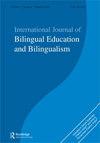Translanguaging for a hopeful future
IF 2.5
2区 文学
Q1 EDUCATION & EDUCATIONAL RESEARCH
International Journal of Bilingual Education and Bilingualism
Pub Date : 2023-05-15
DOI:10.1080/13670050.2023.2212836
引用次数: 0
Abstract
In this special issue, Guest Editors Sabrina Sembiante and Zhongfeng Tian set out to frame translanguaging as a Pedagogy of Hope, specifically, the hope that by adopting a translanguaging pedagogy, teachers can help counteract the pervasive monoglossic bias that is so often inherent in the curriculum, instruction, program structures, and the ideologies of individual teachers. The five articles in this issue do indeed provide glimpses of that hope. One significant contribution of this special issue is the wide range of students in various contexts where these pedagogies of hope are being tried out. These include young preschool students with rich linguistic repertoires in bilingual and multilingual education programs (Sembiante et al. and Kirsh and Mortini), predominantly English-dominant elementary school students in a Chinese immersion classroom (Tian and Lau), predominately English-monolingual pre-service and in-service teachers in university ESL methods courses (Ponzio and Deroo), and a bilingual graduate student in a Spanish as a world language program (Prada). The articles largely focused on current and future teachers as agents for enacting translanguaging as a pedagogy of hope, with three of the articles (Tian and Lau, Ponzio and Deroo, and Prada) specifically focused on the transformations in what García, Johnson, and Seltzer (2016) would describe as translanguaging stances, shifts, and designs. In each case, there are clear shifts from ignorance and resistance to varying degrees of acceptance. Tian and Lau’s participant – a native-Chinese third grade immersion teacher deeply concerned about protecting space for Chinese language instruction – really grappled with the concept but was willing to negotiate with Tian as a collaborator and experiment with translanguaging pedagogies. Prada described his participant – a recent immigrant and well-educated language teacher from Latin America –moving from strong ideologies of linguistic purism to embracing translanguaging pedagogy through a process of ‘small epiphanies’ and an overall ‘critical awakening or despertar crítico’. The largely monolingual-English teacher education students in Ponzio and Deroo’s study went through a multimodal entextualization cycle (MEC) with carefully planned tasks that supported their growing understandings of translanguaging as theory and pedagogy. While the bilingual and multilingual teachers in the two preschool studies (Sembiante et al., and Kirsh and Mortini) were already engaging in translanguaging pedagogies, the authors found variations in their translanguaging shifts and designs. They also focus on the agency of the students themselves as they draw on their full linguistic repertoires to engage in their classrooms. I will comment briefly on each article, highlighting findings that stood out to me, and connecting them with my own observations and experiences as a former bilingual (Khmer) teacher, as a teacher educator, and as a researcher. I’ll then conclude by returning to the theme with comments on the hope I find in this special issue. Sembiante et al. focused on the Show and Tell time in dual language bilingual education (DLBE) Spanish-English preschool classrooms. They grapple with one of the major tensions in our field as we seek to move away from the historical practice of insisting on the strict separation of languages in bilingual classrooms. Such practice ironically reinforces a parallel version of the monolingual bias, with monolingual instruction in two named languages stacked side-by-side. While we know that为充满希望的未来翻译语言
在本期特刊中,客座编辑Sabrina Sembiante和田忠峰着手将跨语言教学视为一种希望的教育学,特别是希望通过采用跨语言教学法,教师可以帮助抵消课程、教学、课程结构和教师个人意识形态中普遍存在的单语言偏见。本期的五篇文章确实提供了这种希望的一瞥。这期特刊的一个重要贡献是,在不同的背景下,学生们都在尝试这些希望的教育方法。其中包括在双语和多语言教育项目中拥有丰富语言曲目的幼儿学生(Sembiante等人以及Kirsh和Mortini),在汉语沉浸式课堂中以英语为主的小学生(Tian和Lau),在大学ESL方法课程中以英语单语职前和在职教师为主(Ponzio和Deroo),以及一名西班牙语世界语言项目(Prada)的双语研究生。这些文章主要集中在当前和未来的教师身上,他们是将跨语言作为一种希望教育法的推动者,其中三篇文章(田和刘、庞齐奥和德鲁以及普拉达)特别关注García、Johnson和Seltzer(2016)所描述的跨语言立场、转变和设计的转变。在每一种情况下,都有明显的转变,从无知和抵制到不同程度的接受。田和刘的参与者——一位母语为中国的三年级沉浸式教师,非常关心保护汉语教学空间——确实很难理解这个概念,但愿意与田作为合作者进行谈判,并尝试跨语言教学法。普拉达描述了他的参与者——一位来自拉丁美洲的新移民和受过良好教育的语言教师——通过“小顿悟”和整体“批判性觉醒或蔑视”的过程,从强烈的语言纯粹主义意识形态转向接受跨语言教育。在Ponzio和Deroo的研究中,大部分英语教师教育学生都是单语学生,他们经历了一个多模式的互文化循环(MEC),精心计划的任务支持了他们对跨语言作为理论和教育学的日益理解。虽然两项学前研究中的双语和多语言教师(Sembiante等人,以及Kirsh和Mortini)已经在从事跨语言教学,但作者发现他们的跨语言转变和设计存在差异。他们还关注学生自身的能动性,因为他们利用自己的完整语言曲目参与课堂。我将对每一篇文章进行简短的评论,强调对我来说突出的发现,并将其与我作为前双语(高棉语)教师、教师教育工作者和研究人员的观察和经历联系起来。最后,我将回到主题上来,对我在本期特刊中看到的希望发表评论。Sembiante等人专注于双语教育(DLBE)西班牙语-英语学前课堂中的表演和讲述时间。当我们试图摆脱在双语课堂上坚持严格分离语言的历史做法时,他们正在努力解决我们领域的一个主要紧张局势。具有讽刺意味的是,这种做法强化了单语偏见的平行版本,两种命名语言的单语教学并排堆叠。虽然我们知道
本文章由计算机程序翻译,如有差异,请以英文原文为准。
求助全文
约1分钟内获得全文
求助全文
来源期刊
CiteScore
7.90
自引率
7.10%
发文量
93
期刊介绍:
The aim of this Journal is to be thoroughly international in nature. It disseminates high-quality research, theoretical advances, international developments to foster international understanding, and to spread ideas about initiatives in bilingualism and bilingual education. The Journal seeks: • To promote theoretical and applied research into bilingual education and bilingualism. • To provide a truly international exchange, and to encourage international debates and discussions on key issues in areas of controversy in bilingual education and bilingualism. audience.

 求助内容:
求助内容: 应助结果提醒方式:
应助结果提醒方式:


